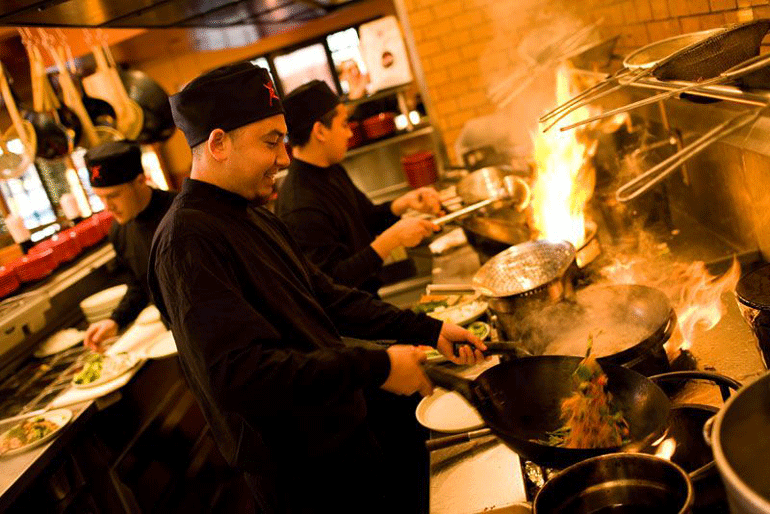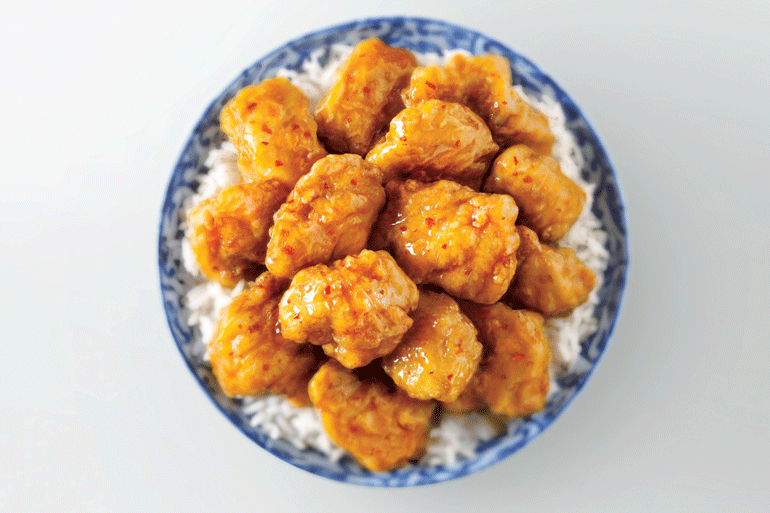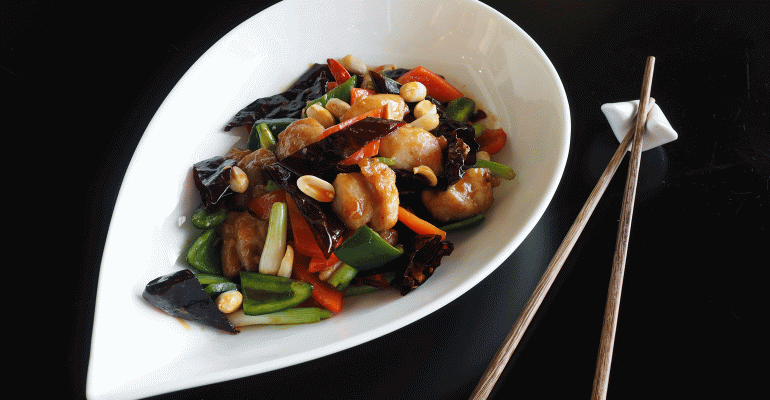The past century of Chinese food in America has been a period of adaptation.
Chinese immigrants adapted dishes to the tastes of their customers, and the result was orange chicken, shrimp lo mein, beef and broccoli, and other Chinese takeout icons.
Now, the evolution continues as chefs contend there’s room for both elevated versions of those Americanized dishes and more authentic takes on the complex and ever-evolving cuisine.
“It becomes a synergy that, hopefully, is a little more interesting than your traditional dining experience,” said Tommy Lee, owner of Hop Alley, a hip Chinese restaurant in Denver that familiar dishes like orange beef, fried wontons and lo mein as well as more obscure dishes like mapo dofu and salt-and-pepper soft shell crabs.

Hop Alley
A balancing act
Some chefs have an uneasy relationship with Americanized Chinese dishes. On the one hand, orange chicken, beef with broccoli, and pork fried rice are the products of assimilation and can often bear little resemblance to their cuisine of origin.
“Crab cheese wontons and egg rolls could be considered in the same breath as French fries and hot dogs as ‘American’ food,” Lee said.
On the other hand, they’re a testament to the adaptability of the cuisine and the strength and resilience of its cornerstone flavors and techniques.
“I believe every single dish that came from that era was important and valuable,” said Chris Cheung, chef and owner of East Wind Snack Shop in Brooklyn, N.Y., and co-owner of Tansuo in Nashville. He’s also a leader of the Asian Food Mafia, a group of chef friends determined to evolve the cuisine.
“For me, there’s no denying that the art of Chinese food is centered around technique and taste. Its origins speak to that.,” Cheung said. “[But] it was affected by the need for volume and speed. Add to that a streak of racism against it and you have a stain on an otherwise great cuisine.”

Beef and broccoli by Chris Cheung
Restaurants are increasingly using updated versions of classics — with higher-quality ingredients and attention to detail — to get customers in the door, where they can perhaps introduce more adventurous diners to new flavors.
“First, you’re eating sesame chicken and beef with broccoli, then it’s onto dim sum, numbing Sichuan peppercorns and Peking Duck,” Lee of Hop Alley said.
J. Sullivan, director of culinary innovation at Irving, Texas-based Pei Wei Asian Kitchen, which has more than 200 locations, said Chinese-American items are an important part of the chain’s offerings.
“While we do try to have a balanced, pan-Asian feel to the menu, what Americans expect of Chinese food is the comfortable Chinese takeout that we grew up with,” he said. “It’s not a surprise to me that our top sellers were Mongolian Beef and General Tso’s Chicken before Orange Chicken was introduced.”

Pei Wei Asian Kitchen
George Chen, co-founder and executive chef of China Live, a San Francisco food hall and marketplace, and Eight Tables, its fine-dining restaurant, sees Chinese food’s history in the U.S. over the last 100 years and recognizes a lot of good things, but also problematic elements. At Eight Tables, where pot stickers involve delicate latticework and foie gras, Chen wants to push forward.
“It was the first affordable ethnic cuisine, dotted across America for a century,” Chen said. “That stigma of, “To be good, it has to be cheap,” is still very much with us … These perceptions continue to haunt a great cuisine, so it’s our mission to demystify and educate on what real Chinese food is.”
At Eight Tables, Chen aims to draw parallels between well-known takeout dishes and their traditional roots.
Take Egg Foo Young, for example.
“It’s actually derived from the velvet technique, a slow oil poaching with egg white to create a soufflé-like texture,” Chen said. That technique is featured in his dish of velvet chicken with matsutake mushrooms, truffles and roasted miso-veal jus.

Cucumber at China Live
The basics, but better
Another item at Eight Tables that draws on a classic Chinese-American dish is Broccoli Beef in Oyster Sauce. Chen acknowledged that an item with that or a similar name, “is on, like, 35,000 Chinese menus across America. But our elevated version at Eight Tables is seared, medium-rare A5 Miyazaki Wagyu with baby gai lan (Chinese broccoli), soy caviar and fried Willapa Bay oysters in a house-made oyster sauce.”
Pei Wei’s Orange Chicken, which was introduced last month, is another example of the chain’s new focus on better ingredients, Sullivan said.
Essentially, the culinary team set out to build a better Orange Chicken.
“There’s really no classical definition of these dishes because they were changed and Americanized to begin with,” Sullivan said. “It’s interpretation by owner. So we gave it a premium element with breast meat cut and breaded in-house, not frozen dark meat in big bags.”
The dish is elevated with an in-house brine, a light tempura batter and real oranges. It’s priced at $5.

Orange chicken at Panda Express
“If you’ve always been a fan of Chinese takeout, I want our food to remind you of the experience you’ve always had,” Sullivan said. “But I also want to make it more enticing for people who are more discerning about their food. I think we can ride the fence.”
In a testament to the adaptability of these classic dishes, Panda Express took a different route with its long-running popular Original Orange Chicken. It was developed back in 1987 with a Sichuan appetizer in mind: Chenpi Niurou, or “tangerine peel beef.”
“We’ve switched the beef for chicken, introduced a heady element of sweet and sour alongside the citrus and chile notes,” said chef Jimmy Wang, director of culinary innovation at Panda Express, a Chinese-American food chain with more than 2,000 locations.
The chain this month introduced Wok-Seared Steak and Shrimp, a one-plate experience that “embraces multiple courses of a familiar steak house dinner, from appetizer to entrée, with the addition of signature Panda Express flavors,” Wang said.
“We are many guests’ first foray into Chinese food,” he added, “and aim to create a flavorful variety of dishes that are approachable and bring together both Chinese and American taste preferences.”
In 2014, Panda opened the Panda Express Innovation Kitchen in Pasadena, where new ideas are tested for the chain. Menu developments to come out of the test kitchen include an orange chicken bing and a tea bar.
At Cheung’s Nashville restaurant Tansuo, General Tso’s Chicken and Beef and Broccoli are both on the menu, their appealing aspects not lost on Cheung.
“I love the technical ability to take chicken and cook it so it’s lathered in this sweet and sour sauce but yet remains crispy,” said Cheung, who grew up in a Chinese community in New York City, worked in the kitchens of Jean Georges and Nobu and merged the cooking disciplines of those worlds, as well as their ingredients.
“I’m able to use the whole pantry of Chinese ingredients and seasonings and use great local American products as well,” he said
For General Tso’s Chicken, Cheung uses the most flavorful part of the chicken: big, juicy pieces of thigh. They’re brined, cooked with the skin on for flavor and crispness, then double battered and fried twice, first at a lower temperature and then at high heat for a “super crispy” result, Cheung said.
“Then, the sauce is made hot and bubbly and it’s all tossed together” for that perfect moment in time when the chicken is totally crispy and simultaneously coated in the sticky, sweet “lick your fingers type sauce,” he said.
Beef and Broccoli is also elevated with falling-apart, slow-cooked short ribs, thinly sliced Chinese broccoli and fried broccoli leaves. The traditional oyster sauce is made special with the addition of abalone, “a surf-and-turf masterpiece,” Cheung said.
“The customers love [the updated classics],” he said. “Some needed a little explanation because it differed from their usual takeout, but everyone really appreciated the modern twist.”
Contact Tara Fitzpatrick at [email protected]





